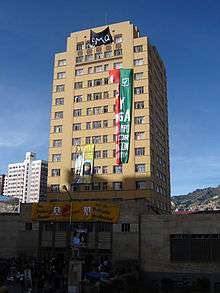Higher University of San Andrés
| Universidad Mayor de San Andrés | |
 Monoblock, the central building of the University | |
| Established | October 25, 1830 |
|---|---|
| Vice-Chancellor | Ing.Carlos España Vásquez |
| Rector | Dr. Waldo Albarracin |
| Location | La Paz, Pedro Domingo Murillo Province, Bolivia |
| Website |
www |
 | |
The Higher University of San Andrés (Universidad Mayor de San Andrés or UMSA) is the leading public university in Bolivia established since 1830 in the city of La Paz (seat of government). UMSA is the second oldest university Bolivia after the University San Francisco Xavier de Chuquisaca (1624).
It is one of the most prestigious higher academic centers in the country, a participant in many social movements during different periods of government in the history of Bolivia, both teaches and factum of national education. In the field of students, until 2013, the Universidad Mayor de San Andrés in their classrooms had around 80,434 students, making it the university with the largest student body in Bolivia.
It should also be mentioned that several presidents of Bolivia, made his studies at the university, graduating from their classrooms, as well as different lawyers, engineers, politicians, doctors and other professionals who went on to become prominent figures within Bolivian society during the passing of the nineteenth century, the twentieth century and twenty-first century.
In 2014, the Webometrics ranking I place this university in the first place in Bolivia, a total of 49 universities considered.
History
The university was created by Andrés de Santa Cruz by Supreme Decree on 25 October 1830.[1] Due to the commercial influence of La Paz, since its creation, the Higher University of San Andrés has influenced the social life and history of Bolivia. The university's history consists of three well-defined periods. From its inception in 1830 until a June 1930 revolution the university was official.[1] From 1930 to the 1936 advent of the University Rectorate, position filled by Héctor Ormachea Zalles, the university was a semi-autonomous or municipal university.[1] From then until the present, the university has been autonomous.[1]
Headquarters
The building that now hosts the university's main offices, known as Monoblock, is located on Avenue Villazón. It was designed in 1942 by architect Emilio Villanueva and is considered an iconic example of Bolivian architecture. The building is part of a university complex inspired by Pre-Columbian architecture that never fully materialized. Construction started in 1942 and concluded on 4 July 1947. It was criticized for being the first skyscraper in the city.
It is also an epicenter of social movements and many congregate there after marching downtown.
It has 13 floors, 11 of which are used for classrooms. It contains the most complete library in the country, an auditorium that is open to the public for various events, and a semi-subterranean garden with access to the central atrium. The library was created in 1930.
Due to the high demand for rooms, various pavilions and two buildings were built in the surrounding areas. They are separated from Monoblock by open areas and the remnants of the military college, also designed by Villanueva.
Colleges
The university has the following colleges
- Law and Political Sciences
- Medicine website
- Architecture, Arts, Design, and Planning website
- Social Sciences website
- Economics and Finance
- Humanities and Education website
- Pharmaceutical and Biochemical Sciences website
- Engineering website
- Mechanics
- Pure and Natural Sciences website (which maintains the Max Schreier Planetarium and the Astronomical Observatory of Patacamaya)
- Dentistry
- Agronomy
- Earth Sciences
Doctor honoris causa
- Gregorio Baro, Argentine scientist
- Jaime Escalante, Educator
References
External links
Coordinates: 16°30′17″S 68°07′48″W / 16.50472°S 68.13000°W